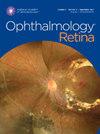Risk and Dose–Response Relationship for Pentosan Polysulfate Sodium Maculopathy
IF 5.7
Q1 OPHTHALMOLOGY
引用次数: 0
Abstract
Topic
To determine the pooled relative risk (RR) of pentosan polysulfate sodium maculopathy (PPSM) in patients using pentosan polysulfate sodium (PPS) and model the dose–response relationship of this association from existing literature.
Clinical Relevance
Pentosan polysulfate sodium maculopathy is an acquired, progressive retinal pigmentary disease associated with oral PPS use. Although several observational studies suggest a dose–response relationship of this association, to date, there remains no literature-pooled synthesis on the risk of PPSM across strata of cumulative dose.
Methods
Systematic review and meta-analysis (CRD42024623179). Medline, Embase, and Cochrane Central Register of Controlled Trials were searched from inception to September 15, 2024. We included studies reporting the incidence of PPS-associated maculopathy and including cumulative PPS dose information. Two independent reviewers completed study screening, data extraction, and risk of bias (ROB) assessment using the ROB in nonrandomized studies of exposures tool, and a third reviewer was consulted to resolve conflicts. The primary outcome was the RR of PPSM among patients exposed to PPS compared with nonexposed individuals, stratified by cumulative PPS dose.
Results
We included 5 studies encompassing 141 785 patients and 6432 PPSM cases. The linear dose–response regression model estimated a 0.1% increase in RR of maculopathy per g increase in cumulative PPS dose (log-transformed RR = 0.00101; 95% confidence interval, 0.0005–0.0015; P < 0.0001). Patients with cumulative doses ≥2000 g exhibited an RR of 7.39 (95% confidence interval, 4.17–13.10), while those with a dose between 1 and 500 g had an RR of 1.65 (95% confidence interval, 1.12–2.43) compared with nonexposed individuals. Subgroup analysis excluding high-risk studies demonstrated consistent findings, with reduced heterogeneity (I2 = 63.7%).
Conclusion
Moderate certainty evidence supports a dose-dependent relationship between PPS exposure and PPSM risk, whereas higher cumulative doses significantly increase maculopathy risk. This result supports that patients should be tapered to an effective minimal dose and that they should be subject to interval maculopathy screening, especially for patients with greater cumulative dose. Future research should incorporate patient-level data to better control for potential confounding.
Financial Disclosure(s)
The authors have no proprietary or commercial interest in any materials discussed in this article.
戊聚糖聚硫酸钠黄斑病变的风险和剂量-反应关系:系统回顾和荟萃分析。
主题:从现有文献中确定戊糖磷酸钠黄斑病变(PPSM)患者的总相对危险度(RR),并建立该关联的剂量-反应关系模型。临床相关性:PPSM是一种获得性进行性视网膜色素疾病,与口服PPS使用有关。尽管几项观察性研究表明这种关联存在剂量-反应关系,但迄今为止,仍没有文献汇总综合跨累积剂量层的PPSM风险。方法/文献回顾:系统回顾和荟萃分析(CRD42024623179)。Medline, Embase和CENTRAL从创建到2024年9月15日进行了搜索。我们纳入了报告PPS相关黄斑病变发生率的研究,包括累积PPS剂量信息。两名独立审稿人使用非随机暴露研究的偏倚风险(ROBINS-E)工具完成研究筛选、数据提取和偏倚风险(ROB)评估,并咨询第三名审稿人以解决冲突。主要结果是暴露于PPS的患者与未暴露个体相比PPSM的相对风险,按PPS累积剂量分层。结果:我们纳入了5项研究,包括141785例患者和6432例PPSM病例。线性剂量-反应回归模型估计,累积PPS剂量每增加g,黄斑病变的RR增加0.1% (logr = 0.00101, 95% CI: 0.0005-0.0015, p < 0.0001)。与未暴露个体相比,累积剂量≥2,000 g的患者的RR为7.39 (95% CI: 4.17-13.10),而剂量在1-500 g之间的患者的RR为1.65 (95% CI: 1.12-2.43)。排除高风险研究的亚组分析结果一致,异质性降低(I2 = 63.7%)。结论:中等确定性证据支持PPS暴露与PPSM风险之间的剂量依赖关系,而较高的累积剂量显著增加黄斑病变风险。该结果支持患者应逐渐减少有效的最小剂量,并应接受间隔性黄斑病变筛查,特别是对于累积剂量较大的患者。未来的研究应纳入患者水平的数据,以更好地控制潜在的混淆。
本文章由计算机程序翻译,如有差异,请以英文原文为准。
求助全文
约1分钟内获得全文
求助全文

 求助内容:
求助内容: 应助结果提醒方式:
应助结果提醒方式:


